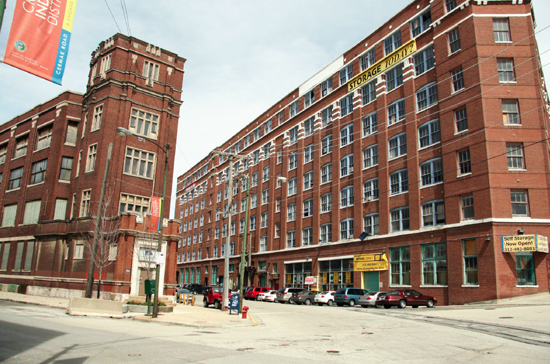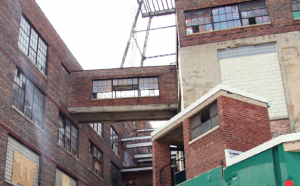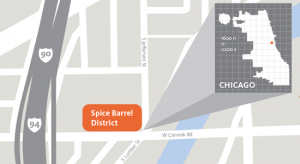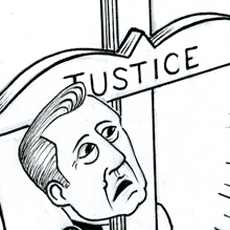Chicago locals respond to the city’s plans for a new creative district
Photos by Alli Berry & graphic by Patrick Jenkins
Chicago’s ambitious plan for the development of four near-south warehouses could significantly impact Chicago’s creative economy. Poised on the river between Chinatown and Pilsen, this small area is the city’s most intact grouping of early 20th-century industrial waterfront buildings, linked to the rest of Chicago by a period lift bridge (the last of its kind in the city). It used to be called the Spice Barrel District, a name taken from the former life of one of its historic structures, a spice importing and processing company. Today, it’s being rehabbed and re-branded by the City of Chicago’s Department of Cultural Affairs as the Cermak Creative Industry District. The DCA has begun looking for consultants on the project, which has a yet-to-be-determined timeline and an estimated cost of over $100 million dollars that will be covered by rent, private investments, and grants.
Planners hope to encourage all industries under the broadly-defined “creative” umbrella by providing practical accommodations to meet the various needs of graphic designers, dancers, and any other artists in the applied, performing, and visual arts. The Cermak Creative Industry District is devoted both to the historic preservation and revitalization of the Cermak corridor, and to providing new outlets and opportunities for artists of all kinds; but as New City editor Jason Foumberg pointed out in a 2010 article that strongly supported the project, “galleries and studios will be just a small fraction of the big picture, if at all.” That is, the goal of the district is to encourage new businesses of many kinds (from graphic design studios to cafes) as much as it is to support artists.
Cultural activity is nothing new to these buildings, some of which have been inhabited by artists and their studios, legally and illegally, for several decades. But according to Barbara Koenen, cultural planner for the DCA, such activity couldn’t flourish until the city got involved. Cultural historian Tim Samuelson, Koenen’s husband, acquired landmark status for the buildings in 2006, saving the 800,000 square feet of space from an uncertain fate and paving the way for the initial planning stages. “Because they are landmarked, their character has to be preserved, and some conventional industry might have wanted to change them or tear them down to build something else. Now they can’t, and the city is working on changing the zoning to accommodate what the arts and culture industry needs,” Koenen told F Newsmagazine.
Koenen, who is also the director of the Chicago Artists Resource website and an artist in her own right, points out that it’s very early to be discussing specific details about the process. “It’s a formal urban planning process, as opposed to other creative districts in the city that are the visions of individuals or groups, like the Zhou brothers or the Podmajerskys,” she says. “Hopefully we can mirror the successes of those visions and expand on their limitations.” Koenen added that she felt the Cermak Creative Industry District could only benefit the other arts districts in Chicago.
It might be early, but things are already moving along. Last summer, the National Endowment for the Arts and the Mayor’s Office of City Design awarded the project a grant to help with the research and planning phases. In February, the DCA conducted the Creative Chicago Survey with part of the grant money to improve their understanding of the range of creative activity in the city, and to “foster creativity in terms of space, programs and other assistance.”
An important part of the plan is the incorporation of arts incubators to help small-business start-ups. “[The term] ‘creative industry’ [implies] that it’s a business model and that financial transactions are taking place, so it’s not envisioned as being a place where people are subsidized to do whatever they want,” Koenen says. “It’s job creation and economic development. Incubator projects will be there to help individuals create things that can be bought or sold, so that will exclude some types of practice.”
Creative Industry Abroad: Potential Models for Chicago
Adelheid Mers (Professor of Arts Administration at SAIC) explains that funding for the arts is a balance that involves the complex interconnectedness of many factors. “The arts cannot be streamlined across the board to be profitable as other businesses can, and they need to be subsidized if their continued presence is desired,” she says.
The future of Cermak could look something like the Cable Factory in Helsinki, Finland, one example of an arts district subsidized by a major city. Museums, galleries, theaters, ateliers, and an event space for concerts make up this creative center, within a political and social environment for artists that is unlike that in the United States. “Artists have a strong voice in how state funds are being allocated, which also means that they have to be willing and able to participate in those negotiations,” Mers says. But, “as public funds are currently being cut in Europe, it is becoming clear that there is no philanthropic tradition to make up for losses.”
Mers notes that, in contrast, the U.S. market economy relies heavily on philanthropy and artists’ continued willingness to contribute their labor. Even limited use of tax monies for the arts is heavily contested, and Cermak appears to be “an effort to create a mutually constitutive environment, similar to something countries with large public sectors can produce, for example in Helsinki, by convincing the stakeholders — building owners, politicians, artists, and larger entrepreneurs — to work together.”
In China, Beijing’s 798 Arts District is a celebrated example of turning an under-utilized industrial relic into a revitalized area of the city, cultivating a post-Mao era explosion of contemporary art and culture. However, Mers says that, in reality, the district has “no real non-profit structure and only limited entrepreneurial opportunities, and is entirely controlled by the state. As Ai Weiwei’s recent arrest reminds us, while Chinese artists have been allowed access to Western markets, they still have no voice. To allow artists to temporarily work in a beautiful, disused factory is not a model. It is a short-lived façade.” The district has also barely averted closure and demolition because of the rising cost of real estate and the rapid development of the city.
A Future SoHo? Chicago artists respond to the plan
Industry adds an important element to the arts and cultural economies, says Mers, and she notes this shift in how society thinks about art. “Instead of saying that ‘the arts are good for society,’ now the tenet is ‘creativity is an economic good,’” she points out. Artists here in Chicago understand this tension first-hand.
Edmund Chia, SAIC professor and founder of the artist-run space PERIGRINEPROGRAM in the Riverfront Work Lofts in the Cermak district, sees promise in any effort that will create a new pocket of creative workspace in the city. However, he’s realistic about the city’s directive. “Foot-traffic numbers and tenant counts present only one kind of ‘success.’ At the individual level, there are creative workers who need space more than they rely on walk-in customers,” he told F. “A live/work situation is very different than one [that is] work-only, and a solely commercial zone will only attract businesses that can thrive there. In an ‘organically’-developed zone, creative workers find their own level and position.”
Arts Administration student Katie Fahey (MA ’11) is writing her thesis on arts districts and has researched Cermak and other areas like it around the globe. “The economic return on investment is really more than ever being emphasized in undertakings of this nature, [and] there is the danger that this project could turn into a tourism-focused, commercial district. But hopefully it won’t,” she says.
And Koenen emphasizes that although a new, burgeoning cultural center in Chicago will draw visitors, tourism is not the central goal. “Navy Pier is for tourism — this is about giving people a place to work and make things,” she says.
Still, Fahey sees a possibility that Cermak could precipitate a shift towards an economy-driven, “displaying” kind of arts district, as opposed to a place that fosters creative development, experimentation, and production. “I think there needs to be a sense of not necessarily sustainability, per se (because that implies a stagnation in culture), but a balance in growth,” she says.
As an artist that runs his own gallery space, SAIC student Dave Sharma welcomes the development, but is cautious as to what it will mean for young artists 10-15 years from now. “Creating low cost spaces is definitely positive for artists and developers. However, artists have historically established these neighborhoods only to be priced out during times of redevelopment and economic growth, and become victims to gentrification,” he says. “The whole project could potentially be used by developers to create a community, create occupancy and revenue, only to be flipped and sold to another developer when the cultural equity has been built.”
There’s a prime example of this type of failure very close by to the Cermak Creative Industry District site. The Pilsen neighborhood’s Podmajersky arts district has left 18th Street little more than a stretch of empty storefronts that were once filled with galleries and studios. UIC Professor Daniel Sauter is the last tenant in his live/work space in Pilsen, and is planning to relocate shortly. “By not paying property tax for vacant buildings, the developer can ‘afford’ to artificially direct rental level in a monopolistic manner,” he told F Newsmagazine. “The fact that there are only Podmajersky buildings in the 18th Street area, and the heavy-handed approach by the developer to keep it that way, is the reason that this is a privatized marketing effort more than an artist-driven district.”
Sauter has high hopes for Cermak and its position as a counterpart to Chinatown and Pilsen. He believes that, as a city-supported vision that carefully considers infrastructure, Cermak would dynamically impact surrounding areas as well. “A vision that considers price/rent development long-term would send the right signal in regards to commercialization, and protect non-profit and small business creative industries,” he says.
Fahey hopes that the project will address Chicago’s oft-discussed problem of “MFA graduate flight.” “While many artists are educated in Chicago, they leave when they’re done,” she says. “Those artists, who are no longer affiliated with an institution, need access to equipment and studio space. If the city serves that need, they might succeed in retaining a solid base of artists who not only will continue to contribute to the creative vitality of the city over time, but will also feel a sense of loyalty to place.”











….so, if I wanted to know more about this neighborhood, what is the first step??
-Kevin
….so, if I want to know more about this neighborhood, what is the first step??
-Kevin
Hi Kevin, here are some links to check out:
http://www.chicagoartistsresource.org/dance/node/22431
http://www.cityofchicago.org/city/en/depts/dca/provdrs/resources_and_servicesforartsorganizations/news/2011/jan/cermak_rfq.html
http://www.arts.gov/artworks/?tag=cermak-creative-industry-district
You can also “like” Cermak Creative Industry District on Facebook
thanks for a thoughtful and comprehensive article. just a few corrections, for the record.
1. The ULI Tap team created the name “Spice Barrel District” in their 2007 report, that is the only time that name has been used. It is not the historical name.
2. Cermak is not being “rehabbed” by the Chicago Dept of Cultural Affairs (which is now the Chicago Dept of Cultural Affairs and Special Events), though you could say this process will”rebrand” it by the City.
3. The DCA issued an RFQ for consultant teams, which is different than “looking for consultants”. It is important to emphasize that there is a formal process underway. Also, the $100M project cost that ULI posited in their 2007 report (I think that’s where Mia got the project cost) assumes acquisition of the properties, which is not the current scenario. So that figure is not accurate.
3. Tim didn’t “acquire landmark status” but did write recommendations for landmarking the district. However, the actual process was formally undertaken by the Landmark Commission staff and approved by the commission.
4. The NEA/MICD matching grant is paying for consultants to undertake urban planning, historic preservation guidelines, incubator development and creative industry district management development. LISC paid for the Creative Chicago Survey.
It is great to read the artists’responses. Thanks for writing about the project.
What is the current status/plan regarding restaurants…apartments?